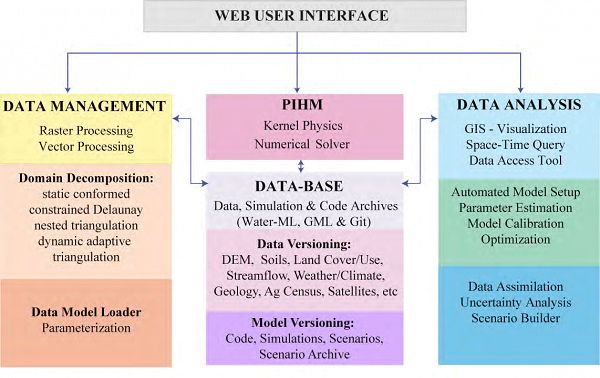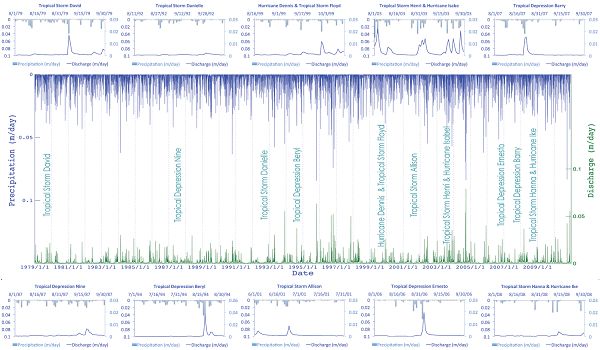Watershed Modeling Research Group
This group is tagged with:
-
Hypothesis: When compared to similar but less intensive observations for watersheds chosen along environmental gradients, the observed and predicted rates of regolith formation at Shale Hills provides the basis for quantification of hydrologic and hydrochemical prediction as well as identification of storage reservoirs and preferential pathways in shale-dominated landscapes.
In order to test the hypothesis above and to evaluate our “predictive understanding” of water, solute, energy, and sediment cycles, it was necessary to rapidly implement a first-class observing system at the Susquehanna-Shale Hills CZO and to continue to build a new generation of environmental models capable of simulating pathways, time scales and feedbacks of the system processes. It is not widely recognized that watershed modeling is a data-intensive process. Our approach to synthesis of experimental data and computational models began by developing webbased GIS tools that allow rapid model prototyping and archiving by, with fast access to terabytes of CZO and national data with online data mining, and visualization tools geared to users that are not modelers or scientists but rather focus on policy, planning and decision making. The CZO LIDAR VIEWER (http://pihm.ics.psu.edu/CZO_NOSL/Default.aspx) is one example. Although the process is still underway, a model-data integration framework is presently being tested at the Penn State Institute for CyberScience facility for data intensive computing using the Shale Hills testbed. The facility will provide support on-line access to visualization, data analysis tools and other resources necessary for model setup, simulation, scenario building and CZO science support. We have downloaded the necessary national data sets so that model input for weather, climate, soil, land cover and geology for all watersheds in the US. The basic workflow is illustrated in the figure above. In principal all data and models would reside in a private “CZO-cloud” accessible by all with most technical details transparent to users. The hardware is designed for data-intensive web-based applications and model analysis that are connected to a private cloud to distribute the work load and make the details of model input preparation transparent to the user.PIHM Model: The Penn State Integrated Hydrologic Model (PIHM) is a multi-process, multiscale hydrologic model for Numerical Watershed Prediction (NWP), where the major hydrological processes are fully coupled using the semi-discrete finite volume method. Instead of coupling through artificial boundary conditions, major hydrological processes are fully coupled by the semi-discrete finite volume approach. For those processes whose governing equations are partial differential equations (PDE), we first discretize in space via the finite volume method. This results in a system of ordinary differential equations (ODE) representing those processes within the control volume. Within the same control volume, combining other processes whose governing equations are ODE’s, (e.g. the snow accumulation and melt process); a local ODE system is formed for the complete dynamics of the finite volume. After assembling the local ODE system throughout the entire domain, the global ODE system is formed and solved by a state-of-art ODE solver. PIHM represents a simulation strategy for the solution of process equations at the watershed and river basin scales, and includes a tightly coupled GIS tool for data handling, domain decomposition, optimal unstructured grid generation, and model parameterization. Atmospheric forcing for the watershed from 1979 to present uses the North American Land-Data Assimilation System (NLDAS-2). We have completed the first goal for this element of our research to assimilate the historical and modern measurement data to produce a complete 30 year hydroclimatic history for the site, with all important land surface and subsurface states simultaneously simulated in space and time. The future of environmental observing systems will certainly utilize embedded sensor networks with continuous real-time measurement of hydrologic, atmospheric, and ecological variables across diverse terrestrial environments. However, the value and contribution of historical data must also be assessed and preserved where it adds to our understanding of the terrestrial water cycle.
Reanalysis 1979-2011: Watershed reanalysis research is being carried out at the Susquehanna-Shale Hills Critical Zone Observatory (CZO) in central PA to reprocess and assimilate observational data collected at various periods at Shale Hills over a 40+ year span, into a fully coupled integrated hydrologic model at the testbed. Early observations in the 1970’s consisted of a spatial array of 40 groundwater level sites measured daily, daily soil moisture records, and 15 minute streamflow records. These data was used for empirical studies by forest hydrologists to resolve the role of antecedent moisture in runoff peak flows within a forest canopy. Over the last 3 years the CZO effort has followed up the early experimental research by deploying a real-time and spatially distributed embedded sensor network (30 sites as of Dec 2010) of soil moisture, soil temperature, soil conductance, groundwater levels, -temperature, -conductance, matric potential, snow depth (15 minute sampling). Shale Hills has a 30m tower with eddy covariance, net radiation, IR surface temperature, and for precipitation a disdrometer, load cell gauge along with a network of tipping bucket rain gauges (10 minute data). Results of watershed reanalysis and data assimilation over the last 30 years demonstrate the impact of tropical storms on runoff for the Susquehanna-Shale Hills CZO.
Age Modeling for Stable Isotopes: There is now a wide literature on the use of tracer age and transit time distributions to diagnose transport in environmental systems. Theories have been proposed using idealized tracer age modelling for ocean ventilation, atmospheric circulation, soil, stream and groundwater flow. Most approaches assume a steady flow regime and stationarity in the concentration (tracer) distribution function for age, although recent work shows that this is not a necessary assumption. In this paper (Duffy, 2010), dynamic model for flow, concentration, and age in volume-averaged and a spatially distributed watershed system are derived in terms of the moments of the underlying distribution function for tracer age, time, and position. Several theoretical and practical issues are found:
(1) The low-order moments of the age distribution function are sufficient to construct a dynamical system for the mean age and concentration under steady or transient flow conditions.
(2) Solutions to the coupled system of equations for flow, concentration and age show that ‘age’ of solutes stored within the watershed or leaving the watershed is a dynamic process which depends on flow variations as well as the solute or tracer dynamics.
(3) Intermittency of wetting and drying cycles leads to an apparent increase in the tracer age in proportional to the duration of the ‘dry’ phase.
(4) The question of how mobile/immobile flow may affect the age of solutes is examined by including a low permeable, passive store that relaxes the well-mixed assumption.
(5) A spatially distributed advective and dispersive transport solution for age evolution over a simple 1-D hillslope is developed to demonstrate the age theory for a distributed source of water and tracer, and the solution is shown to have very similar input–output behaviour when compared to the volume-average model for comparable parameters.The SSHO_CZO stable isotope network is currently being used to evaluate the “age” and residence times of stable isotopes at Shale Hills as part of an integrated hydrodynamic model for water, solutes and sediments.
For more information contact:
Christopher Duffy (PI),
Xuan Yu (Ph.D student), Gopal Bhatt (Ph.D student), Lorne Leonard (Ph.D student)"Figure 1. Typical workflow for PIHM within the Model-Data Integration Framework we are developing at Penn State. Other physical models and tools can be added as required (Phase 5 CBM would be done first under Activity 2). Note that the data and model are accessible as a web service with online GIS and visualization tools. Versioning of simulations, scenarios and the models are handled through Git version control system (http://git-scm.com) or similar. A desktop interface is also available for modeling and GIS data handling locally using open-source software (http://www.pihm.psu.edu), with integrates with the web service for model input setup and local model execution.
Shale Hills Hydrologic Reanalysis for Streamflow.
-
Contacts
-
Shale Hills, INVESTIGATOR
7 People
INVESTIGATOR
.(JavaScript must be enabled to view this email address)
Penn State
Stochastic and numerical modeling of groundwater flow and solute transport, modeling large-scale hydrologic systems.
GRAD STUDENT
.(JavaScript must be enabled to view this email address)
Hydrological and land surface modeling
INVESTIGATOR
.(JavaScript must be enabled to view this email address)
multiphase flow and transport, environmental engineering, and geochemistry
INVESTIGATOR, Visiting/Affiliate, COLLABORATOR
.(JavaScript must be enabled to view this email address)
Groundwater Hydrology
INVESTIGATOR
.(JavaScript must be enabled to view this email address)
Numerical modeling of land surface and subsurface. Data assimilation in land surface hydrologic modeling system.
INVESTIGATOR, PostDoc
.(JavaScript must be enabled to view this email address)
Water-rock interactions; Upscaling; Spatial heterogeneity; Mineral dissolution and weathering
GRAD STUDENT
.(JavaScript must be enabled to view this email address)
Integrated hydro-land surface-chemical modeling
Alumni-Former
GRAD STUDENT
Hydro-thermo-chemical modelling
COLLABORATOR, GRAD STUDENT
.(JavaScript must be enabled to view this email address)
modeling
GRAD STUDENT
.(JavaScript must be enabled to view this email address)
Hydrology, Biogeochemistry
GRAD STUDENT
.(JavaScript must be enabled to view this email address)
Groundwater - surface water interactions
GRAD STUDENT
Wetland hydrology, hyporheic hydrology, Distributed watershed modeling for ecosystem services
-
Explore Further














